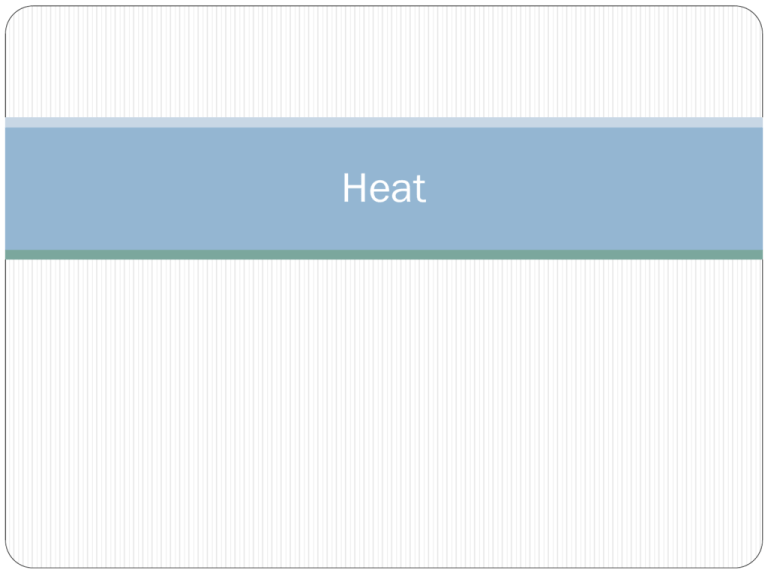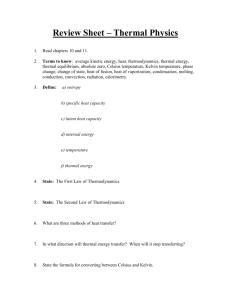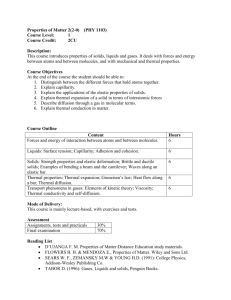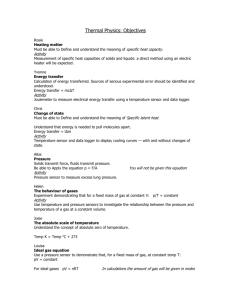Heat - PrairieSouth Staff Sites
advertisement

Heat Heat and Temperature Kinetic Molecular Theory – Is the theory that matter is made up of atoms (smallest piece of matter) and that these atoms are in continuous random motion Atoms may join together to form molecules Solids usually maintain both their shape and their volume Liquids maintain their volume, but not their shape Gases do not maintain their volume or their shape – they will expand to fill a container of any size Molecular motion is random Molecular motion is greatest in gases, less in liquids and least in solids Collisions between atoms and molecules transfers energy between them Molecules possess kinetic energy Molecules in gases do not exert large forces on one another, unless they are colliding Thermal energy – is the average of the potential and kinetic energies possessed by atoms and molecules experiencing random motion Energy that is stored inside matter, The total of the kinetic energy of its molecules as it moves (colliding, spinning and vibrating) And their potential energy as they move closer together and further apart Heat – is the thermal energy transferred from one object to another due to differences in temperature Q heat = E thermal Heat is measured in Joules (J) • There is no direct method to measure heat – only indirect methods Heat can be transferred by: Convection – it is the transfer of heat due to fluid movement (mixing hot and cold water in a tub, air in an oven to cook food) Conduction – it is the movement of heat through solids or between two solids that are touching (cooking on a stovetop, the pan on top of the stove. The stove heats the pan at the bottom of the pan, but it is not just the bottom of the pan that gets hot, the handle of the pan often gets hot also) Radiation – this energy transfers as a wave, like an x-ray or gamma ray, or as thermal energy (microwave) Temperature – is a measure of the average kinetic energy of the molecules of a substance (how hot or cold something is) It can be measures with a thermometer Measuring the amount of thermal expansion or contraction that occurs within a given type of substance The units are Celsius Kelvin Scale (absolute scale) sets 0K as absolute zero (-273.15oC). Temperature increases on the scale are the same as the Celsius scale (1K = 1oC) Conversion K = oC + 273 Absolute zero can never be reached – because by definition absolute zero is the temperature at which all molecular motion ceases. Thermal Expansion Most substance expand when heated and contracted when cooled. However, the amount of expansion or contraction varies, depending on the material Experiments indicate that the change in the length L of almost all solids is (approx) directly proportional to the change in temperature T. The change in length is also proportional to the original length of the object Lo. That is, for the same temperature change a 4m long ion rod will increase twice as much in length as a 2m long ion rod Thus L = Lo T Where is the proportionality constant that is called the coefficient of linear expansion for the particular material and has the units (oC)-1 or (K)-1 It does vary slightly with temperature This is important in the design of certain structures Volume Expansion – the change in volume of a material which undergoes a temperature change is given by the relation V = Vo T is the coefficient of volume expansion and has the units (oC)-1 or (K)-1 This is key for gases – important to recognize any potential hazardous situation which could result in an increase in pressure in closed containers) Note that for solids, is normally equal to approx 3 However this is not true for solids that are not isotropic (isotropic – having the same properties in all directions) Note that there is no linear expansion for liquids or gases since they do not have a fixed shape Specific Heat Capacity and Latent Heat Specific heat capacity (c)– is the quantity of heat required to raise the temperature of a unit of mass of a substance by a unit change in temperature (or raise 1kg of water 1oC) c = Q__ or Q = mcT mT Q – change in heat content (Joules – J) m – is the mass (kg) c – is the specific heat capacity (J/kg oC) T – change in temperature (oC or K) the specific heat capacity of a substance depends on its molecular structure and on its phase Calorimetry – quantitative measure of heat exchange that takes place in a calorimeter. To determine the specific heat capacity of substances Specific Latent Heat – of a substance is the quantity of heat energy required to change the state of a unit mass of substance (heat required for a change in phase) EL = ml EL – heat transferred (Joules – J) m – mass of the substance (kg) l – latent heat of the particular process and substance (J/kg) Specific Latent Heat of Fusion (lF)– is the quantity of heat energy released when 1kg of a substance solidifies (fuses) without changing its temperature Specific Latent Heat of Vaporization (lv) - is the quantity of heat energy needed to vaporize 1kg of a substance without changing its temperature Water Has one of the largest specific latent heats of fusion of all substances It exhibits a high specific heat capacity compared to other liquids It exhibits anomalous behavior: From 0oC to 4oC it contracts as heated. It also expands when it freezes. The expansion results in a decrease in density, allowing ice to float on water. Thermodynamics Thermodynamics – is the name we give to the study of processes in which every is transferred as heat and as work Heat – transfer of energy due to a difference in temperature Work – is a transfer of energy that is not due to a temperature difference System – is any object or set of objects that we which to consider Closed system – no mass enters or leaves Open system – mass may enter or leave A transfer of heat energy occurs when substances having different temperatures are allowed to mix First Law of Thermodynamics – law of conservation of energy (in any transformation of energy the total amount of energy remains constant) Second Law of Thermodynamics – Principle of heat exchange (when 2 substances of different temperatures mix, heat travels from the hotter substance to the colder one) Heat energy lost = heat energy gained EH (lost) = EH (Gained) To look at heat exchange it must occur under controlled conditions – calorimeter to look at: Qualitative properties – look, texture, etc Quantitative properties - measurements Third Law of Thermodynamics – Entropy (part of the system that can increase or stay the same – the amount of randomness) Heat Engines Is a device which converts heat energy into mechanical work Remember that no devise transfers energy completely into work – for that reason it is impossible to build a perfect heat engine Efficiency can be calculated as follows Efficiency = useful energy output x 100% Energy input Heat Pump (or refrigerator) - Just the reverse of a heat engine – requires an application of work to transfer heat energy form a low temperature to a high temperature







